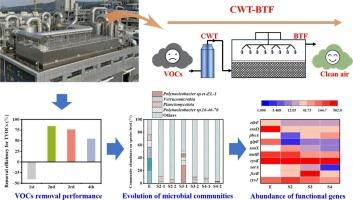Pilot-scale reactor for removing VOCs from a biowaste treatment plant: removal performance, degrading microorganisms, and their functional genes
IF 7.1
2区 环境科学与生态学
Q1 ENGINEERING, ENVIRONMENTAL
引用次数: 0
Abstract
The widespread generation and treatment of biowaste contribute to odorous volatile organic compounds (VOCs) emissions and health issues and are a challenge to contemporary society. This study designed equipment that integrated a chemical washing tower (CWT) with a biotrickling filter (BTF) to remove VOCs from a biowaste treatment plant and reduce associated health risks. The total VOC concentrations at the biowaste treatment plant ranged from 700.1 to 1800.0 ppb and aliphatic hydrocarbons and volatile organic sulfur compounds (VOSCs) were the dominant VOCs. The inoculum added to the system contained Bacillus, Burkholderia, and other effective microorganisms. It removed 97.9 % of VOSCs (5 ppm) within 3 days under laboratory conditions. At the pilot scale, the combined CWT-BTF system removed 84.0 % of VOCs, with the BTF unit demonstrating superior performance compared to the CWT. The health risks of some VOCs decreased after purification, although the non-cancer and cancer risks remained above acceptable levels. After inoculation, the dominant microorganisms in the BTF changed from Bacillus, Klebsiella, and Burkholderia pseudomultivoran to Polynucleobacter, Verrucomicrobia, and Planctomycetota, which were primarily involved in energy metabolism pathways. Additionally, Polynucleobacter sp. 16-46-70 was found to be involved in sulfur metabolic pathways. Genes related to sulfur metabolism (cysK, cysJ, and metB) and nitrogen metabolism (gltB, GDH2, nirB, and niT) were involved in VOCs removal in BTF. This study indicates that the CWT-BTF technique at suitable loading rates is an effective method for removing VOCs emitted by biowaste and offers insights into the bacteria and genes that hold potential for enhancing removal efficiency.

从生物垃圾处理厂去除挥发性有机化合物的中试反应器:去除性能、降解微生物及其功能基因
生物废物的广泛产生和处理导致有气味的挥发性有机化合物(VOCs)排放和健康问题,是当代社会面临的挑战。本研究设计了将化学洗涤塔(CWT)与生物滴滤器(BTF)集成在一起的设备,以去除生物废物处理厂中的挥发性有机化合物,并降低相关的健康风险。生物垃圾处理厂挥发性有机化合物(VOC)总浓度在700.1 ~ 1800.0 ppb之间,以脂肪烃和挥发性有机硫化合物(VOCs)为主。添加到系统中的接种物含有芽孢杆菌,伯克氏菌和其他有效微生物。在实验室条件下,它在3天内去除了97.9%的voc (5ppm)。在中试规模试验中,CWT-BTF组合系统去除了84.0%的VOCs,与CWT相比,BTF装置表现出更好的性能。净化后,一些挥发性有机化合物的健康风险有所降低,但非癌症和癌症风险仍高于可接受水平。接种后,BTF中的优势微生物由芽孢杆菌、克雷伯氏菌、伪多角伯克氏菌转变为多核杆菌、Verrucomicrobia和plantomycetota,主要参与能量代谢途径。此外,发现多核杆菌sp. 16-46-70参与硫代谢途径。与硫代谢(cysK、cysJ和metB)和氮代谢(gltB、GDH2、nirB和niT)相关的基因参与了BTF中VOCs的去除。本研究表明,在合适的加载速率下,CWT-BTF技术是一种有效的去除生物废弃物中挥发性有机化合物的方法,并为提高去除效率的细菌和基因提供了新的思路。
本文章由计算机程序翻译,如有差异,请以英文原文为准。
求助全文
约1分钟内获得全文
求助全文
来源期刊

Waste management
环境科学-工程:环境
CiteScore
15.60
自引率
6.20%
发文量
492
审稿时长
39 days
期刊介绍:
Waste Management is devoted to the presentation and discussion of information on solid wastes,it covers the entire lifecycle of solid. wastes.
Scope:
Addresses solid wastes in both industrialized and economically developing countries
Covers various types of solid wastes, including:
Municipal (e.g., residential, institutional, commercial, light industrial)
Agricultural
Special (e.g., C and D, healthcare, household hazardous wastes, sewage sludge)
 求助内容:
求助内容: 应助结果提醒方式:
应助结果提醒方式:


